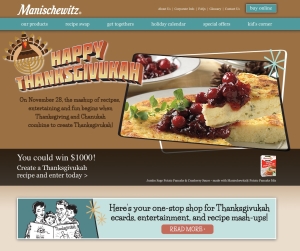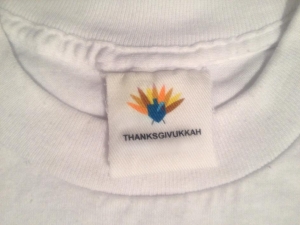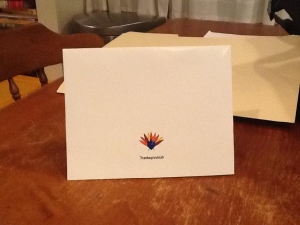Holiday Trademarks: THANKSGIVUKKAH?
Yes, Thanksgivukkah. Loyal fans of my Holiday Trademarks series (Halloween, Thanksgiving, Winter Holidays Part I, Winter Holidays Part II, and Happy New Year!) must think I’m getting pretty desperate. But since the next Thanksgivukkah won’t happen until the year 79,811, and since I was planning on retiring this blog on my 75,000th birthday no matter what, I guess we should talk about this “event” and its trademark implications.
Thanksgivukkah, of course, refers to the rare occasion when the first day of Hanukkah falls on the same day as Thanksgiving in the U.S. Due to some sort of convergence between the Hebrew lunisolar calendar and our familiar Gregorian calendar, the last Thanksgivukkah happened in 1888, and apparently it won’t happen again until the 799th century, on which date I definitely expect to receive all the G.I. Joe toys I requested for Hanukkah back in 1983.
The portmanteau (a combination of two or more words into one word, whether or not that word was really necessary in the first place) was coined in 2011 by Dana Gitell, a Boston-area marketing specialist. The idea has taken off, and there are a variety of merchandising tie-ins related to this most sacred of occasions. For example, the homepage for Manischewitz, the nation’s largest manufacturer of processed kosher food products, currently looks like this:

If that doesn’t want to make you revolt against King Antiochus III the Great of Syria, I don’t know what will.
Accordingly, earlier this year, Ms. Gitell obtained two trademark registrations with the United States Patent and Trademark Office for the mark THANKSGIVUKKAH: one for “Clothing, namely, t-shirts, one piece garments for babies, and baby bibs not of paper,” and the other for “Greeting cards; Paper party decorations; Wrapping paper.”
I suppose that should prevent anyone from using the word THANKSGIVUKKAH as a trademark affixed to those goods in the US. Or should it?
When one applies to the USPTO for a trademark registration, before that registration is obtained, one must provide a specimen showing how the mark is being used in interstate commerce. From the USPTO website:
A specimen is a sample of how you actually use your mark with the goods and/or services identified in your application in the commercial marketplace (e.g., on your product packaging or website). It is not the same as the drawing of the mark, which shows only the mark you want to register. So, a specimen is generally what consumers actually see when they are trying to purchase your goods or services.
Here was Ms. Gitell’s specimen for the apparel registration:

And here was her specimen for the paper goods registration:

The record indicates that both specimens were accepted by the USPTO without further review. To me, these look like they were one-offs that were created for the purpose of generating specimens for the USPTO applications, not finished products as they were sold in interstate commerce. The clothing tag has ragged edges, and the print on the card looks faded, as though it was a homemade sample. I haven’t purchased or seen these products in the real world, so I don’t know for sure. It’s certainly possible that if you order a shirt or card from Ms. Gitell, this is exactly what you’d receive. But it doesn’t look right to me.
All of which is to suggest that, if Ms. Gitell were to attempt to enforce her trademark rights against an alleged infringer, she might be compelled to demonstrate the validity of the samples she provided in her USPTO applications.
I suppose this will all be moot after November 28, 2013. If Ms. Gitell can figure out a way to leverage her THANKSGIVUKKAH marks in future years, when Hanukkah falls closer to Christmas and gets mixed up with that holiday instead, more power to her. I suspect that, by the time her trademark registrations require renewal (which would be between 2018 and 2019), the THANKSGIVUKKAH craze will be a distant memory.

